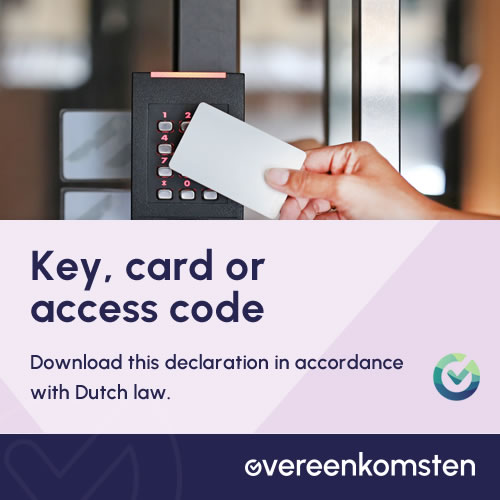Keyholder Agreement
€ 7,95 incl. btw
A keyholder agreement is an agreement between the owner of a space and someone who needs access. You can use this model for employees, but also for users of e.g. an office, shop premises, restaurant or hair salon.
Secure checkout
Description
Sample keyholder agreement
You want to give someone independent access to a space, So that person must be given a key. That could be a physical key or a keycard or other system, such as a code for the alarm.
With this keyholder agreement, you ensure that it is clear that this person has received a key. In doing so, they also sign for the responsibility that comes with it. For example, the keyholder may not make a copy of the key. In case of loss or theft, this must be reported immediately. In principle, they are liable for damage if the key is lost or stolen.
You can use this keyholder agreement in many different relationships. The most common is the one where an employee is given access to the workplace, but also, for example, in the case of co-use of an office space or use of a barber’s chair. In short, in all situations where someone is given access to your environment.
What to fill in yourself
Details of both parties and their relationship. Ensure that it is duly signed on behalf of the key provider.
Summary
Contains provisions on:
- Key number;
- Key holder responsibility;
- Not making a copy of key;
- Description type of key;
When do you use a keyholder agreement?
If you don’t document anything then the general rules on due diligence apply. This is not always remotely sufficient. For instance, you want to make sure someone does not make a copy of the key. It is always wise to document this. Then it is clear what responsibility comes with having a means of access.
Who uses a keyholder agreement?
On the one side is the person entitled to the space. This could be the employer, the main tenant or the owner. That person wants to give someone independent access. That person is called the keyholder. So the relationship can take many forms. An organisation with its director, an employer with an employee, or a tenant with a co-user. You could even use the keyholder agreement separately when letting a house or holiday home temporarily.
Specifications
| Bestand |
Word-document |
|---|---|
| Taal / Language |
Engels |
| Aantal |
2 pagina's |









Beoordelingen
Er zijn nog geen beoordelingen.